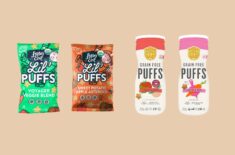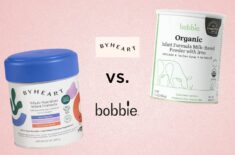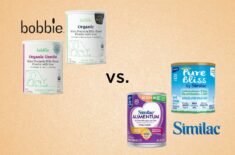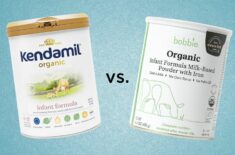Overview
Baby-led weaning (BLW) is a way of introducing solid foods to your baby that encourages them to self-feed and direct their mealtime experiences. This method skips purées and spoon-feeding in favor of finger foods. It can promote independence. But is it safe and effective?
For decades, most parents have chosen purées as their children’s first solid foods because these are soft and can be easier for small mouths to swallow.
Many believe that kids fed with puréed baby foods may have a lower risk of choking.
However, recent studies showed that those who started with baby-led weaning might have the same choking risk as those given soft foods. (1)(2)
Popularized by authors Gill Rapley and Tracey Murkett with the publication of “Baby-led Weaning: Helping Your Baby To Love Good Food (2008)” in the UK, the movement has reached the US.
Many moms like it because it’s touted to help develop a confident, healthy eater. And those who have tried the method also recommend it. (1)(2)
A June 2024 Nutrition Journal study showed that BLW can improve weight-for-length and weight-for-age scores compared to conventional feeding. The study addresses concerns that BLW might not meet babies’ nutrition needs because they choose what and how much they eat (based on the food caregivers prepare). (14)(15)
The study found that babies received similar energy intake with either method (BLW or conventional feeding). The researchers acknowledge, however, that there could have been discrepancies with the data self-reported by these babies’ caregivers. (14)(15)
So, when your child is ready for solid foods, you can start baby-led weaning.
But always consult with your pediatrician before starting solids, especially if you’re planning on using this method.
At what age can they start, and what foods should you introduce first? What do pediatricians say about baby-led weaning? Is it alright to mix purées and this baby-led feeding method? Find out below.
Benefits Of Baby-Led Weaning
Studies have shown that this feeding method can be beneficial for your baby. (1)
Babies following this practice can experience the following benefits: (1)
- Less prone to becoming overweight
- Less demanding in food preferences
- Eat the same food as the rest of the family
- Share the same mealtimes with the family
- More interaction with family members
- Early introduction to a variety of foods
- May be less likely to become a picky eater
Introduction to a variety of foods may even help your baby avoid developing allergies in the future. (3)
But always consult with your pediatrician, especially if there’s a family history of allergies. It’s especially important if you want to introduce foods that are also recognized as common allergens (such as tree nuts and shellfish).
Other benefits of this weaning technique can include the following:
- Independence because your child is in control
- Appetite control (they can learn how to stop when full)
- Fewer costs because you won’t need to buy or make purées
- Homemade baby foods (you know exactly what’s in your child’s food)
- Ease with dining out because your baby eats whole foods
- Your child can have fun exploring, inspecting, and tasting different food textures and flavors
- Improvement of fine motor skills, dexterity, chewing skills, and hand-eye coordination (4)
- Develop good eating habits
- Reduced risks of childhood obesity
- No worrying about baby food recalls
In contrast to BLW, it’s easy to sneak in a couple more bites even if your child is already full if you’re using traditional spoon-feeding methods.
Frequently doing this can teach your baby to eat more than they need. This might disrupt their self-regulating mechanisms.
What Do Pediatricians Say About Baby-Led Weaning?
Knowledge and professional opinions about this feeding method may vary among health care professionals.
Some pediatricians recommend this practice but also indicate that it might not be ideal for everyone.
According to Ohio-based pediatrician Kimberly Churbock, MD, feeding methods aren’t a “one-size-fits-all” thing. You don’t have to do things this way just because it worked well with other parents or with your older children. (5)
Many parents worry about their children getting proper nutrition, especially during the first few weeks of baby-led weaning.
Dr. Churbock assures it can be fine, especially because complementary feeding doesn’t mean stopping formula or breast milk feeds.
Still, she encourages parents to consult their pediatricians about what, when, and how to feed their babies.
She also recommends starting with puréed foods.
Arizona-based physician, Dr. Wendi Carlton, explains that there are benefits to BLW, such as promoting healthy eating habits. (6)
“You give them a chance to have food in front of them that they can touch, feel, smell, and know the texture in their mouths. Some kids have texture aversions growing up and this may be because you’re not letting them experience textures on their own early enough,” Dr. Carlton explains. (6)
She also advises parents to talk to their pediatrician before starting BLW, pick safe foods for their babies, and watch them during mealtimes.
However, not all pediatricians know about BLW or say they would recommend it to parents.
A study showed that only 41.9% of health care professionals in Dunedin, New Zealand, were aware of the method. (1)(2)
Because they haven’t directly experienced or observed baby-led weaning, these health care professionals refused to recommend it due to concerns over choking and suffocation. (1)(2)
But they acknowledged that this feeding method might have the following benefits: (2)
- Fewer mealtime battles
- Greater opportunity for shared family mealtimes
- Healthier eating behaviors
- Convenience
- Possible developmental advantages
In contrast, another study showed that 81.8% of Canadian professionals might know the method. They acknowledged that this feeding practice can promote: (1)(4)
- Fine motor skills
- Oral development
But even after acknowledging these potential benefits, only 48.5% of the health care professionals in the study said they would recommend it.
How Do I Start Baby-Led Weaning?
In this feeding method, the emphasis is on your baby’s independence: your child determines when they’ll begin eating solid foods, what they eat, and how much food they’ll have.
You won’t need to make or buy purées, choose what you want them to eat, and feed them with a spoon.
Instead, you give your child some finger foods in this self-feeding technique. Whether they eat it will depend on many factors, including readiness.
Checking For Readiness
Here are some visual clues to check for:
- Your baby can sit on their own
- They have good neck strength
- They can move food to the back of their mouth using jaw movements
- Shows interest in food
- Diminished tongue-thrust reflex (a baby’s tongue reflex that makes them spit something out of their mouth)
Once you observe that they might be ready, you can start by giving them small pieces of food. Examples can be steamed broccoli florets, avocado, or banana bits. You can also give them small strips of chicken or omelets.
You’ll notice that your child might use their entire palm to grasp the food. That’s normal. They still haven’t learned about the pincer grasp (using their thumb and index finger).
As they grow older (around six to eight months), they’ll begin to develop the pincer grasp.
What Age Can I Start Baby-Led Weaning?
Every baby is different and will reach developmental milestones at varied rates. But baby-led weaning usually starts in the middle of their first year.
While you can start giving solid foods to four-month-old infants, it’s important to check for signs of readiness before starting them on baby-led weaning.
If your baby was born prematurely, they might develop later than other children. They might show signs of readiness close to their due date rather than their actual age.
Premature babies might start doing things, including weaning, later. But that’s normal.
Letting Your Child Eat Independently
You shouldn’t force your child to eat everything you give them. In this feeding technique, your baby eats the food they like at their own pace.
Plenty of food might end up on the floor or on your baby, but don’t be tempted to use a spoon to help feed them.
What Foods Should I Start With For Baby-Led Weaning?
Foods the size of your finger can be easier for your baby to grasp. These foods should be firm enough for grasping but not too hard to cause choking.
The ideal food can be long and firm enough for your baby to pick up and hold, while a portion sticks out of their hand to see, explore, taste, and eat.
Some common weaning foods you can start with:
- Spears of fresh fruits such as ripe mangoes, bananas, pears, and avocado
- Strips of cooked vegetables such as squash, carrots, and potatoes
- Shredded or ground meat made into a patty
Choking Hazards
Many moms who’ve tried baby-led weaning recommend it to others because they haven’t experienced major concerns with choking or suffocation. (2)
But 30% may have experienced at least one episode of their children choking on raw apples. (2)
For your baby’s safety, avoid foods that may be choking hazards. Some examples are the following:
- Hard foods such as nuts, apples, and raw carrots
- Hard snacks such as pretzels, nuts, popcorn, corn chips, teething biscuits, cereals, granola bars, or tortilla
- Whole grapes, cherry tomatoes, blueberries, and other uncut round foods
- Hot dogs
- Sticky peanut butter or other nut butters
- Raisins
- Raw, hard vegetables
You can still introduce these foods if prepared differently. Examples are steaming the hard vegetables or smashing or cutting blueberries into small pieces.
Gag Reflex Vs. Choking: What’s The Difference?
These two have similar symptoms; so, it’s important to learn how to distinguish them.
Gagging is a reflex action that is common for babies starting solids, whether purée or BLW. It’s also one of the body’s safety mechanisms to help prevent choking. (3)
Some possible signs of gagging:
- Bringing swallowed food back into the mouth
- Gurgling, sputtering, or coughing loudly
- Your baby’s tongue may be thrust forward
- Possible spit up or vomiting
- Their face might become red
Choking happens when something blocks your child’s airways. It may happen if the gag reflex fails.
Some possible signs of choking:
- Struggling to breathe or cough
- Possible high-pitched sounds while breathing
- Their face and lips might turn blue
Learn to distinguish between the two so you’ll know when to intervene.
Don’t try to stop your baby from gagging or vomiting. Intervening may lead to choking and suffocation. (3)
Choking is a different story because it can be a silent killer. It’s a wise idea to take an infant CPR course so you become familiar with how to perform the Heimlich maneuver on babies and young ones. Call for emergency services. (3)
Cutting Foods For BLW
The AAP (American Academy of Pediatrics) recommends providing your child with foods that are less than half an inch to minimize choking risks. (3)
Here are some ways to cut food for your child’s safety:
- Cut small, round fruits such as grapes, blueberries, and cherry tomatoes into thinner, smaller strips
- Avoid circles or circular designs
- Little batons or stick-like cuts may be preferable
- Peel sausages, fruits, and vegetables before cutting
- Remove bones from fish, meat, or poultry products before cutting
- Remove seeds, including pips (small hard seeds)
Other Ways To Help Reduce Choking Risks
- Never leave your child unattended while eating, even for just a few minutes.
- Discourage older children from sharing their food with your baby.
- Don’t let your child lie down, crawl, or walk around while eating.
- Make sure your child sits on a sturdy but comfortable high chair throughout the meal.
- Don’t serve food in the car seat or stroller.
Other Foods To Avoid
- Commercial or highly processed baby foods, if possible
- Honey can be dangerous to your baby if given during their first year because it can increase the risk of infant botulism. It’s a serious bacterial condition that can cause muscle weakness and trouble breathing. It may be harmless to older kids whose digestive systems can remove toxins. (7)
- Allergens, especially the ones that your child is allergic to
- High-mercury fish, such as tuna, swordfish, shark, king mackerel, and tilefish
- Fruit juices and other sugary drinks
- Sugary treats (jelly beans, M&Ms, Skittles, etc.)
- Smoked or cured meats like bacon and bologne
Allergens
Common allergens can include the following: (8)
- Peanuts
- Tree nuts
- Milk
- Eggs
- Soy
- Wheat and other gluten-containing products
- Shellfish
- Fish
- Sesame
Introducing Allergens To Possibly Prevent Allergies
Though the general rule in food introduction is to avoid common allergens, recent studies show that introducing them early on may actually prevent food allergy development in high-risk individuals. Though current guidelines in the US limit this method to peanuts. (9)
Still, studies show that introducing peanuts and eggs may prevent allergy development when your baby is around six months of age. But you shouldn’t do it before your child is four months old or if they aren’t ready to eat yet. (9)
Introducing complementary foods, a diverse diet, and other possible allergens around this time may also help promote food allergy prevention.
Still, make sure you do it with your pediatrician’s approval. It’s also important to avoid foods that your child is already allergic to.
Also, be careful, especially with peanuts or peanut butter in baby-led weaning, because these can be choking hazards.
Surprisingly, a 2021 study found no link between exclusive breastfeeding and allergy prevention. You don’t have to avoid or try to introduce common food allergens if you’re pregnant or nursing. (9)
Also, using hydrolyzed formula (with broken-down milk proteins) in the first year of life may not have protective benefits against food allergy or sensitization. (9)
Watch For Allergic Reactions
No matter what food you’re introducing, check for signs of allergic reactions:
- Skin swelling
- Tongue swelling
- Difficulty swallowing
- Hives
- Itchy lips
- Sneezing
- Wheezing
Because an allergic reaction can cause breathing troubles and loss of consciousness, it can be potentially life-threatening.
Introducing One Food At A Time
Variety is important in baby-led weaning, but you can introduce different foods gradually so you can easily determine which foods might trigger an allergic reaction in your child.
Tips For Success In Baby-Led Weaning
Dine Together
Babies can learn a lot through observation. So, letting your little one join family meals can be a good idea.
You and the rest of the family can be role models for your baby in terms of how to chew, swallow, and also table manners.
Eating together can also provide your child with positive social and developmental reinforcement.
Just make sure that your older kids don’t share their food with your baby because that can lead to a higher choking risk.
Mixed Approach: Should I Do Baby-Led Weaning Or Purées?
Children younger than eight months may have trouble grasping small foods because they haven’t developed or mastered the pincer grasp.
You can also consider a mixed approach, especially if your child seems frustrated that they can’t grasp the food.
For the first few weeks of self-feeding, your child might do more exploring and tasting than actual eating. So, supplementing with purées can also help provide them with the necessary nutrients.
You can complement BLW (baby-led weaning) with soft foods like whole plain fat or Greek yogurt, oatmeal, applesauce, and purée-textured foods.
But keep providing your child with finger foods even if you’re also feeding them purées. Also, increasingly thicker or lumpier purées can help them transition to finger foods.
Prepare For Messes
Always make sure that your baby’s high chair is clean before every meal so you can put food directly on the tray. But you should also accept that getting messy is just a part of your baby’s feeding process.
Baby-led weaning can be messier compared with spoon-feeding, but you can prepare for it:
- Pick a highchair with easy-to-clean surfaces.
- Put a plastic tablecloth or garbage bag under the highchair for easy clean-ups.
- Choose an art smock or a larger bib.
- Balance “messy” foods with dry ones (but watch out for choking hazards)
Choose Baby-Safe Utensils
Even though you’ll start by letting your child use their fingers for eating, you can gradually introduce them to utensils.
Make sure to choose baby-safe utensils:
- Avoid sharp utensils or regular ones you use for the family
- Choose silicone utensils
- Use BPA-free utensils (BPA or bisphenol-A is a toxic chemical in plastic manufacturing that can affect your child’s health and reproductive system development) (10)
- Avoid letting your child use objects that aren’t designed for eating (including skewers or toothpicks)
Avoid Distractions
Watching TV is a regular part of mealtimes for many families. But many pediatricians recommend limiting distractions such as watching TV.
Without distractions, your child can focus on eating while you or other caregivers can focus on supervising the meal. It promotes bonding and will also help you monitor your child’s safety while eating.
Stay Calm
Gagging can be frightening to you and your baby, but it’s normal in small children. It’s part of your baby’s reflex system to protect their airways from obstructions.
But always watch out for signs of choking.
It can be a good idea for parents and caregivers to take a child-infant CPR course for peace of mind and to help them prepare for emergencies.
Whether your child is gagging or choking, try to stay calm as much as possible. If you panic, your child may also feel the same thing.
What’s Wrong With Baby-Led Weaning?
Junk Foods & Sugary Products
The BLW approach (baby-led weaning) can also have potential disadvantages. It’s often linked to what the family regularly eats.
Babies might also be introduced to junk food earlier in families fond of eating sugary, processed foods. A study discovered that some families may have introduced sugary snacks or trans-fatty foods as their babies’ first foods. (1)
Even if given in smaller proportions, foods like pasta, cheese, bread, sweet cookies, and butter may lead to excessive weight gain, especially in young children. (1)
But if they’re introduced to whole, healthy foods with less sugary or trans-fatty options, kids that started with baby-led weaning may have a minimized risk of obesity.
Iron Deficiency
Before weaning, your child gets their iron needs primarily from breastmilk or infant formula.
But this can become diminished as they begin weaning because some iron-rich foods, such as beef, can be too hard for babies to chew on.
Still, you can try to incorporate these foods into your child’s diet, but make sure they’re not allergic and are ready: (11)
- Seafood
- Red meat (beef, lamb, pork, goat, or venison)
- Eggs
- Poultry (chicken or turkey)
These are good sources of heme iron, the type of iron commonly found in animal products and are readily absorbed by human bodies.
The following plant sources can provide non-heme iron, which is less easily absorbed but can still provide some of this essential nutrient for your baby’s needs:
- Green beans
- Lentils
- Dark green, leaf vegetables
- Tofu
You can also pick iron-fortified infant cereals, but only with your pediatrician’s advice. These foods may be rich in iron, but they may be loaded with added sugars and arsenic. They can also be a choking hazard to smaller children. (12)
For best results, you can give your child foods rich in vitamin C because these can help promote iron absorption: (11)
- Papaya
- Tomatoes
- Cabbage
- Broccoli
- Citrus fruits such as oranges and lemon
- Sweet potatoes
- Berries such as strawberries, raspberries, and blueberries
It’s important to talk to your pediatrician, especially if your child refuses to eat these foods. Your child might need iron supplements to avoid iron-deficiency anemia, which can cause delayed growth and possible susceptibility to infections. (13)
FAQs
Will My Baby Actually Eat Much Food With BLW?
Every baby is different, so there’s no assurance that your child will eat much food because others did at the same time.
You might notice more gagging, exploring, and food throwing or playing than eating during the first few weeks.
But as your child begins to get acquainted with food, they will eventually eat more, though they may take longer to eat as much food as spoon-fed infants.
Do Babies Need Teeth For Baby-Led Weaning?
Not necessarily. But you’ll need to choose the right foods.
You can start with soft ones that baby gums can manage, then eventually introduce harder foods once they grow teeth.
How Do I Know When My Baby Has Had Enough?
It can be easy to tell if your child has had enough food in baby-led weaning because they’ll simply stop eating.
Your child will eventually learn to self-regulate as they understand the sense of hunger and fullness. They aren’t likely to overeat because they’re in control and know what’s going in their little mouths.
REFERENCES
(1) https://www.ncbi.nlm.nih.gov/pmc/articles/PMC6202902/
(2) https://pubmed.ncbi.nlm.nih.gov/23183112/
(3) https://preventallergies.org/baby-gagging-vs-choking/
(4) https://pubmed.ncbi.nlm.nih.gov/26771760/
(5) https://health.clevelandclinic.org/baby-led-weaning/
(6) https://www.dignityhealth.org/articles/baby-led-weaning-the-facts-behind-the-fad
(7) https://kidshealth.org/en/parents/botulism.html
(8) https://www.fda.gov/food/food-labeling-nutrition/food-allergies
(9) https://pubmed.ncbi.nlm.nih.gov/33250376/
(10) https://www.mayoclinic.org/healthy-lifestyle/nutrition-and-healthy-eating/expert-answers/bpa/faq-20058331
(11) https://www.cdc.gov/nutrition/infantandtoddlernutrition/vitamins-minerals/iron.html
(12) https://www.hbbf.org/arsenic-infant-rice-cereal
(13) https://www.mayoclinic.org/diseases-conditions/iron-deficiency-anemia/symptoms-causes/syc-20355034
(14) https://nutrition2024.eventscribe.net/index.asp?presTarget=2742245
(15) https://www.eurekalert.org/news-releases/1048981












